Creating a buzz for your B2B starts with one key thing: content that builds a brand awareness strategy.
Think about it: everything we see online, including blog posts, video, social channels, podcasts, as well as B2B marketing events, has content at the heart of it—but not just any content. Gear marketing materials towards sparking brand awareness for the individual customer and their current purchase phase, then slowly guide them to the desired stage. It goes without saying that content needs to be engaging and memorable in order to do its job: getting customers on the hook.
Guiding customers through the buyer journey means crafting strong, clear, focused content and presenting it at the right time. This guidance is key to building a brand awareness strategy that enables your B2B to thrive.
When you leverage customer-facing opportunities regarding content, it’s important to see brand awareness in stages and create marketing materials that support it in the same way. B2B marketers need to strategize beyond the reach of individual pieces and use content as a way to bolster an overall brand awareness strategy, step by step, to mimic the way customers make purchase decisions.
Connecting the Dots for Customers to Your Brand Through Strategic Content Moves
No matter what industry your B2B marketing serves, there are universal brand awareness phases that act as guidelines for content development. Each phase calls for a particular type of content.
Here are the stages your brand needs to focus on and the specific, targeted content types to turn a browser into a customer.
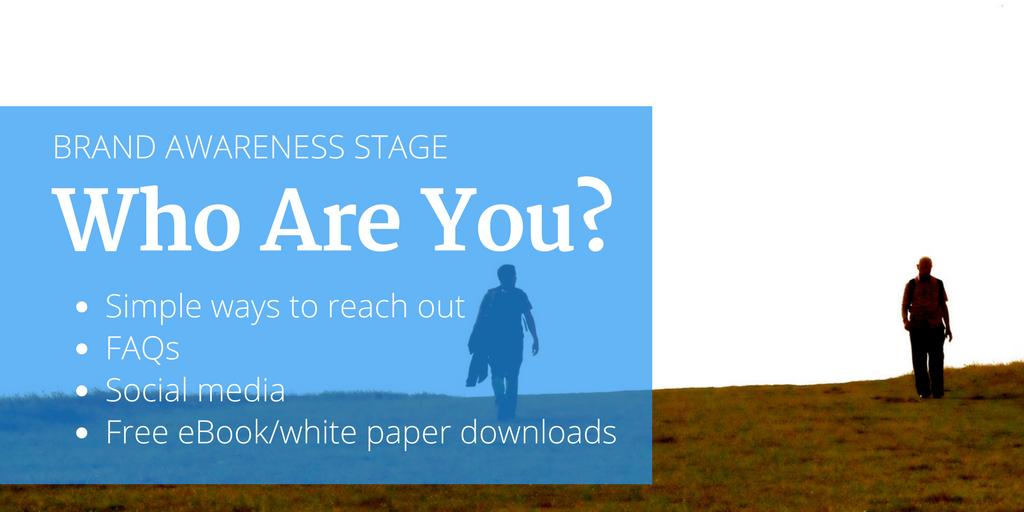
1. Who Are You Stage
At this point, customers have no idea who you are, what you offer, or why they should care. Help them answer all of the above. To build a brand awareness strategy that increases recognition, have a website with simple, user-friendly navigation that shows offerings and the value of what you can do for customers. Pair your website with a brand-focused, memorable logo.
Content should highlight simple ways to reach out for more information or provide clear Frequently Asked Questions (FAQs) with detailed answers. Featuring a blog with solution-focused insights or opinions on industry challenges offers great value and gets an eyeball on the brand.
Once you have a solid bank of content in place, start posting useful and timely content on two to three relevant social media channels to connect with customers where they hang out online.
Remember to interact with people and their relevant insights—don’t just talk about your brand! Adding a few eBooks or white papers for free download can also entice people into getting to know the brand and what it stands for, further providing a way for them to interact with the business at a basic level.
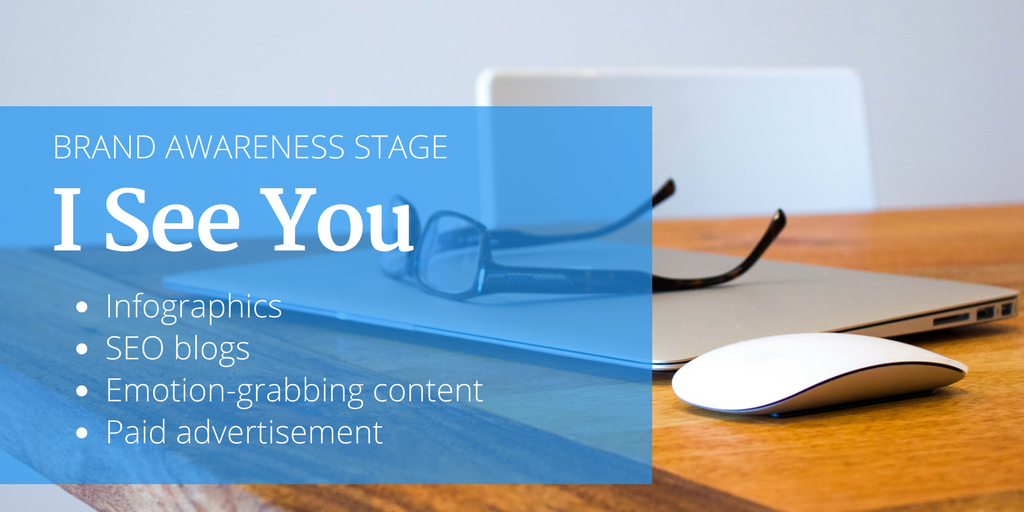 2. I See You Stage
2. I See You Stage
At this point, customers know you but may not need or want to buy from you. Use content, such as infographics, to demonstrate value with helpful industry insights, and use local angles to appeal to folks who shop based on local love. Keep up with outreach through specific social channels, and use analytics to guide content creation that’s finely tuned through SEO towards customer desires and pain points.
During this brand awareness stage, make an effort to offer free trials or a free version with basic tools to build customer traction and interest through experiential use. Now that you have prospects’ attention, leverage storytelling to engage customers on a more personal level. When it comes down to it, emotions are a big part of purchase decisions, especially when you can connect the story you are telling to solving key customer pain points.
Paid advertising on the web and social channels also get marketing content in front of a specific targeted audience interested in your type of offerings. These efforts help people see the brand consistently, which contributes to long-term brand trust you’re building within a key demographic.
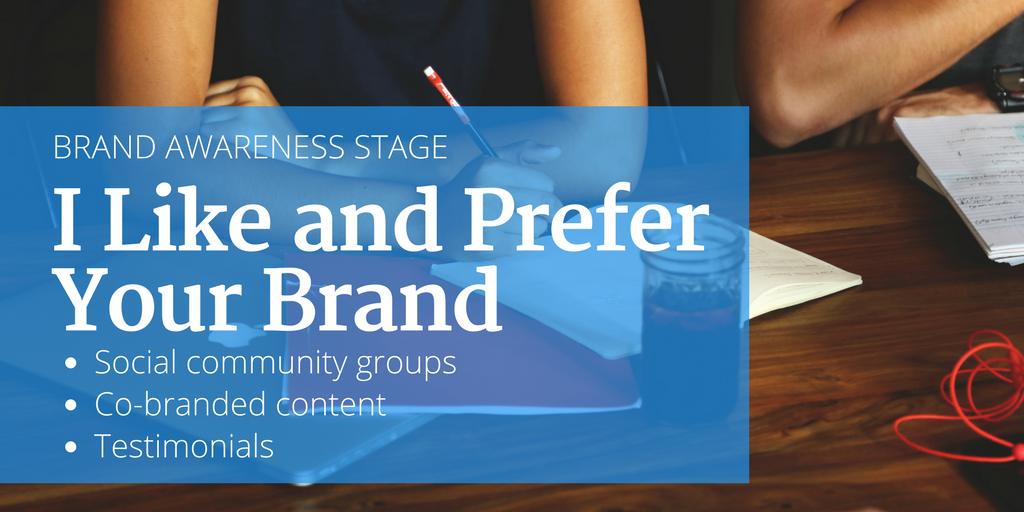 3. I Like and Prefer Your Brand Stage
3. I Like and Prefer Your Brand Stage
For any B2B trying to build a brand awareness strategy, it’s important to cultivate a reputation as a competent and dynamic thought leader. If people already like and prefer you, keep them moving deeper towards pure brand love.
Social platforms, such as LinkedIn, or forums help brands get content out to a bigger audience through a more widely accessible gateway and lead people back to your website for more. Leveraging marketing influencers is another great move at this stage, especially if these influencers are willing to provide testimonials or co-branded content, such as a blog post or video.
A podcast is another significant value-add at this stage. Podcasts provide a space for customers to discuss and discover deeper insights and pass as infotainment, helping position your brand as an expert while sharing substantive insider tips.
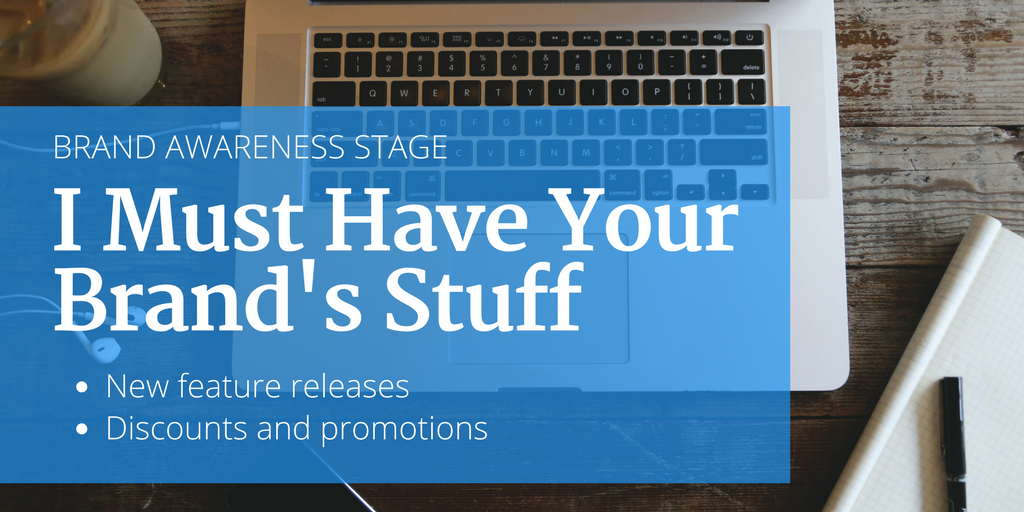 4. I Must Have Your Brand’s Stuff Stage
4. I Must Have Your Brand’s Stuff Stage
People already know about you, may like you, and are committed to sticking with your brand. At this stage, regularly provide new insights, content, and offerings to keep customers engaged beyond the first purchase.
Sneak peeks of new features can be a worthwhile carrot here, as can discounts and special offers for “insiders-only.” Show loyal customers they’re special and that you appreciate their dedication. To raise interest within this particular group of dedicated followers, try a one-off creative piece that features a time-sensitive offer or an upgrade usually only available to higher-tier customers. These followers make great beta testers too, as they provide honest feedback for the sake of helping the brand grow.
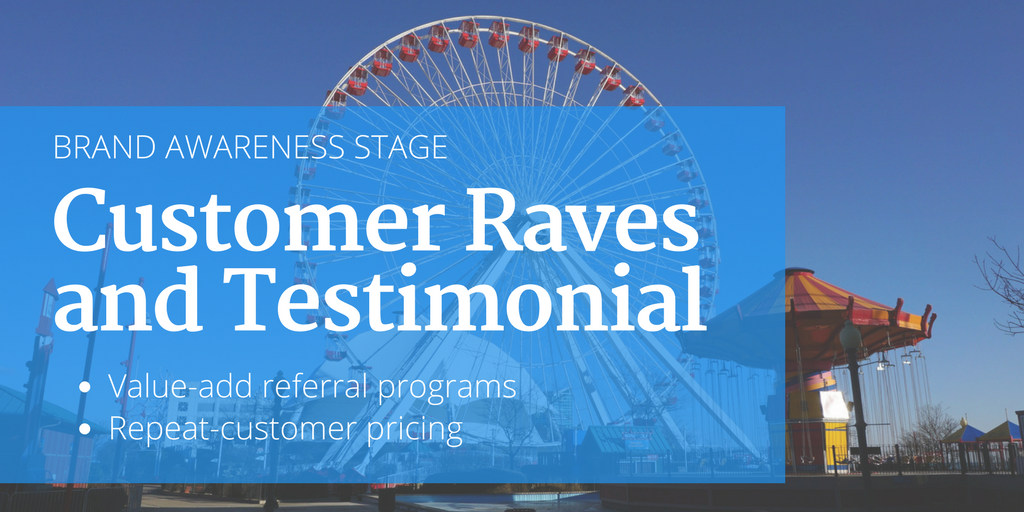 5. Customer Raves and Testimonial Stage
5. Customer Raves and Testimonial Stage
At this point, customers are part of your de facto sales team voluntarily. Honor that loyalty by creating a value-add referral program that rewards them and by asking for testimonials to share on your website and social media. Also, give them a reason to keep talking about the brand by locking them into special rates as a repeat or long-term customer.
Bonus point for building a brand awareness strategy: If you are looking to call back lost customer leads, try remarketing ads shown to previous website visitors that left before moving farther down sales pipeline. It keeps your B2B top of mind and makes them think they missed something by passing on business with your brand.
Every stage in a brand awareness strategy can be a powerful conversion point. Use content strategically to leverage it as the savvy tool it truly is, and make the biggest impact possible during each phase.


